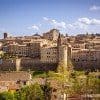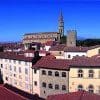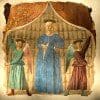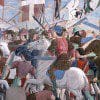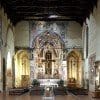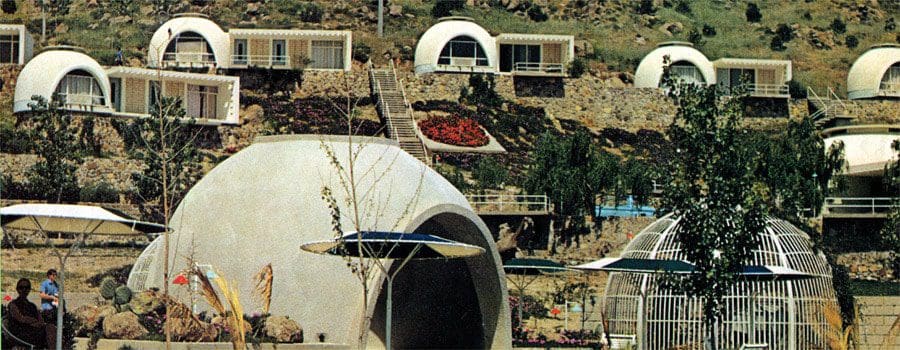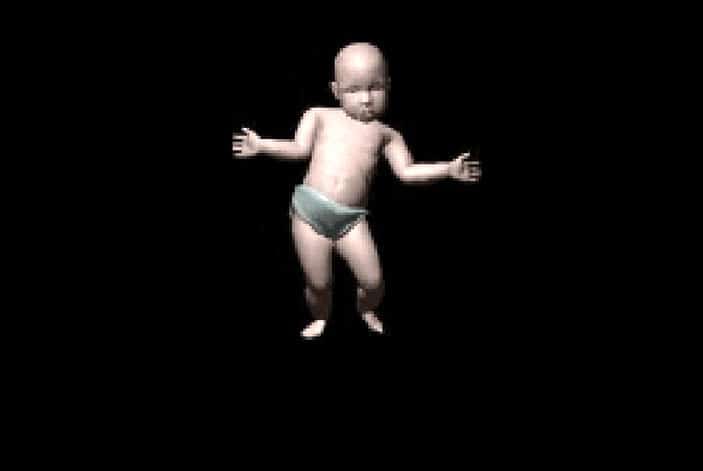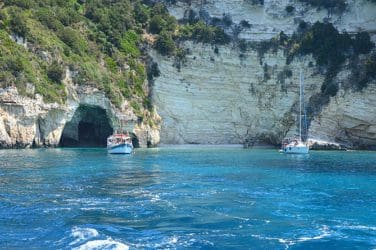words Neil Geraghty
If you’ve ever wondered what travelling back in time to the Renaissance might be like, then Arezzo in Tuscany Italy would be a good place to start.
I’m on an art history tour in the heart of Italy tracing the footsteps of Piero della Francesca, the great early Renaissance painter, but before we begin viewing the multitude of Piero della Francesca artwork, our guide, art historian Susanna Burrichi, wants us to experience the artistic genius that still flourishes in this ancient hilltop town.
On a cobbled street corner we walk into a cluttered atelier belonging to Carlo and Matteo Badii, father and son master goldsmiths who specialize in crafting intricate granulated jewellery. It’s a technique that dates back two and a half thousand years to the Etruscans. Their workshop is an intellectual hotchpotch of dusty bookshelves, artist’s mannequins and antique curios. Both men are immensely proud of Tuscany’s artistic heritage and as Matteo explains, most of the great Renaissance artists were polymaths.
“Take the great Florentine architect Brunelleschi. He was a goldsmith by trade and it was normal in those days to apply your talents to other disciplines.”
Carlo takes some gold nuggets and throws them onto a blackened kiln. He picks up a hose, flicks a switch and a jet of blue flame roars to life. Pointing this at the nuggets, he heats them up to a white hot 1000 degrees before they meld together in a misshapen lump. While it’s still hot, he places the gold into an antique mangle and as he slowly turns the handle, a shimmering gold sheet appears, as crisp and even as freshly made lasagne. He hands the sheet over to Matteo who dons a jeweller’s loupe and with a dainty saw begins carving. After a few minutes he holds up the sheet and an exquisite miniature vine leaf has morphed out of the gold. I’m astonished at the speed of his work, and the vine leaf seems to me the very embodiment of Renaissance craftsmanship.
Birthplace of Guido Monaco, an 11th Century friar who invented the musical scales, and also Petrarch, the illustrious 14th Century poet and father of humanism, Arezzo’s contribution to civilization punches well above its modest size. It feels therefore fitting that the city is also home to one of the great masterpieces of Renaissance art, Piero della Francesca’s “The Legend of the True Cross”. Art enthusiasts travel from all over the world to view this extraordinary cycle of frescoes, and as you enter the unassuming 13th Century Basilica of San Francesco, a hushed aura of whispered reverence hangs in the air. However, before we can view the frescoes, we’re waylaid by the great artist himself, or at least an actor playing the part. He greets us with a theatrical flourish and we cringe with Anglo Saxon embarrassment. Our reaction is noticed by an elderly priest sitting in a confessional box who grins at us like a Cheshire Cat. Despite our reservations, the actor’s performance is convincing, and as he begins relating his life story, his dignified poise and flowing black robes conjure up all the scholarly genius of the Renaissance.
Born into a family of cloth merchants in nearby Sansepulcro in the early 15th Century, Piero della Francesca became an artist’s apprentice at the dawn of Florence’s golden age, and it was while working in Florence that he met many of the leading artistic luminaries of the day including Fra Angelico, Brunelleschi and Donatello. Absorbing the latest trends in humanistic expression, his fame rapidly spread and during his heyday, he spent the summer months trotting around Italy on a donkey to complete commissions for Italy’s great noble families. A gifted mathematician and geometer, his work is imbued with an astonishing degree of accurate perspective which even today draws the viewer into his paintings.
Hanging from the chancel ceiling a giant 12th Century rood cross depicts a gaunt, yellow Christ enduring the Crucifixion. The image is the very essence of austere medieval art, but move behind the cross and you enter a sumptuous world of Renaissance pageantry. In the 1990s the frescoes underwent extensive restoration and Susanna spent 3 years on the project. However before she begins her commentary, she has a confession to make.
“You know, when I started, I didn’t even like early Renaissance painting, but after 3 years, well, I now consider Piero della Francesca an old friend.”
She tells us about the Legend of the True Cross; it was the Da Vinci Code of the Middle Ages, a rollicking saga taken from Jacobus de Voragine’s 13th Century bestseller The Golden Legend. It begins with Adam and the Tree of Temptation and ends in 627 AD with the Byzantine Emperor Heraclius riding into battle against the Persians. Each of the frescoes bears the hallmark of the artist’s genius. Bold classical architectural frames and naturalistic Tuscan landscapes imbue an almost trompe l’oeil 3 D perspective into the frescoes, an effect enhanced by mathematically precise depictions of light and shade, most evident in his beautiful rendering of fabrics. But it is the faces of the characters that are most striking. My gaze is drawn to one scene that depicts The Queen of Sheba meeting King Solomon. Some of the ladies in her retinue stare straight at you while others glance over your shoulder adding an extramural dimension to the composition. Feeling like a fly on the wall, I’m drawn into the action but am rudely awoken when a communion bell rings. The elderly priest who was earlier smirking at us has decided that it’s closing time, and before we’ve even left the church he begins rudely switching off the lights.
Outside, we stroll along cobbled streets past softly floodlit medieval towers and elegant Renaissance colonnades. At a cultural centre we’re greeted by a surprise. The musicians of Arezzo’s medieval festival, the Saracen Joust, have gathered for a practice. Dressed in resplendent harlequin costumes they deafen us with trumpet blasts and drum rolls giving us an exhilarating glimpse of the festivities that Piero della Francesca once enjoyed. More of the ancient culture of Tuscany.
The following morning we set out for the small town of Monterchi where Piero came to paint another masterpiece, The Madonna del Parto. Alongside the Arnolfini Portrait in London’s National Gallery this is one of the world’s most iconic depictions of pregnancy and according to Giorgio Vasari, the 16th Century art historian, Piero came here to paint it after his mother died in 1459. Whether it is a homage to his mother or not, the fresco is certainly a touching homily to all the mysteries of motherhood, and such is the power of the image that even to this day women from all over Italy come to offer prayers for safe deliveries, an importance that has twice saved the fresco from destruction following major earthquakes. Since 1992 it has been housed in a humdrum converted primary school, and when we arrive Susannah is almost apologetic.
“This was only supposed to be temporary but 25 years later, she’s still here. Knowing Italy it will be another 25 years before they find a permanent home,” she laughs. I assure her that this sort of problem is not confined to Italy.
In a darkened room under a protective screen we come face to face with the fresco. It’s an arresting image. Two jaunty angels pull apart a canopy under which the Madonna stands wearing a simple blue maternity dress. Her face is full of contemplation about the impending birth and she places one hand on her belly while with the other she clutches her side. She’s the sort of ordinary expectant mother you might see on the tube during your commute to work: tired, slightly anxious, probably fed up with all the aches and pains and longing for someone to give up their seat! Anyone could relate to this touching humanism and looking down at a basket placed in front of the fresco, I can fully understand why it is full of handwritten devotional prayers.
From Monterchi we drive to Piero’s home town of Sansepulcro where we view another striking depiction of the Madonna, The Politico Misericordia housed in the Civic Museum. Afterwards, we stroll to the municipal library where we meet Marcella Flenghi, an archivist who leads us up to the top floor where Sansepulcro’s town records are kept. On a table she lays out some precious 15th Century books which contain tantalizing glimpses into the artist’s life, much of which remains a mystery. Wearing surgical gloves she carefully turns the pages which are filled with exquisite handwriting as beautiful as a medieval illuminated manuscript. She points to an entry made in 1442 which records Piero’s appointment as a town councillor.
“It was a very important position”, she explains. “He would have been responsible for both maintaining the fortifications of the city and also for appointing doctors. It would have been a great honour.”
The next morning we visit his house, now appropriately an institute for research into Renaissance art. The rambling palazzo is built around a small courtyard and has a well in the basement which was very rare at the time and bears testimony to his wealth. On the first floor a delightful loggia looks out onto the terracotta rooftops and belfries of the town centre, a skyline depicted in many of his works. I could imagine him sitting here in between his travels enjoying fine wine and good conversation and feel glad that, in breaking the artistic conventions of the time, this trail blazing Renaissance man did well for himself.
A week after I arrive back in London I pop into the National Gallery to have a look at the three Piero della Francesca’s in the collection. To reach room sixty-six, where the frescoes are housed I walk through galleries of static Medieval saints peering inscrutably out of golden Gothic frames. Finally in room sixty-six I’m greeted by Piero’s delightful Nativity featuring egg shell blue skies, Tuscan landscapes and faces expressing simple human emotions. Thinking back to what Susannah told me in the Basilica of San Francesco, I too feel as if I’ve stumbled across an old friend.
Fact Box
The trip was hosted and organised by the Terre di Piero Project, a joint project from the Emilia Romagna, Marche, Tuscany and Umbria regions. For more information, go to www.terredipiero.it. Susanna Buricchi, Phd Art Historian and author, is the founder of Artours which organises cultural and art tours around Florence, Siena and Arezzo. For more information please contact Artours www.artours.it
App
An app on the Terre di Piero for both iPhone and Android can be downloaded from itunes App Store or Google Play, containing information on the artists, his works, locations and associated events.
https://itunes.apple.com/bf/app/terre-di-piero/id963688452?mt=8
https://play.google.com/store/apps/details?id=com.apt.pdf&hl=en_GB
Flights
There are regular flights to Tuscany Italy, to Bologna with easyJet and British Airways from London Gatwick, and Ryanair from Stansted, Manchester, Bristol, Edinburgh and Dublin. There are regular flights to Florence with British Airways and CityJet from London City Airport, or with Vueling from London Gatwick.
Hotels
A double room at the Hotel Continentale in Arezzo starts from €95 per night on a bed and breakfast basis. A double room at Residenza d’Epoca Palazzon Maggi in Sansepolcro starts from €80 per night on a bed and breakfast basis. A double room at the Brufani Palace in Perugia starts from €135 per night on a bed and breakfast basis.
Travel: the trail of Piero della Francesca in Tuscany Italy by Neil Geraghty


